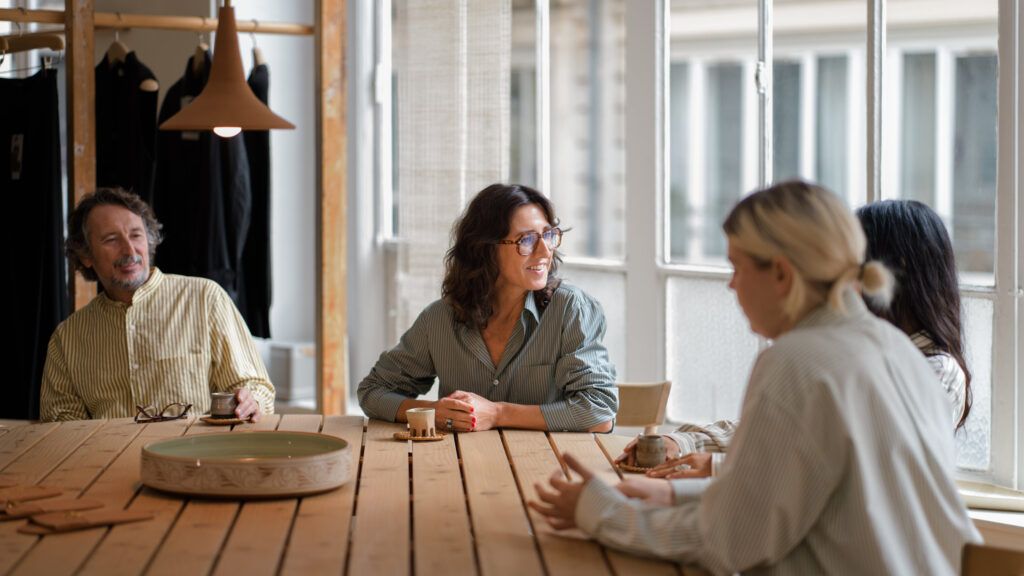
Cristaseya isn’t trying to hide, it just knows that the right people will find it.
Cristaseya is a decade-old clothing line operated by Cristina Casini and her husband Andrea Spotorno, two Italians who moved to Paris nearly 20 years ago from Milan. If you’re lucky enough to know about it, the best place to shop for Cristaseya is the second floor of nondescript office building at 7 Rue Ambroise Thomas in the 9th arrondissement. Not only because the entire collection is there — “This is the atelier, the showroom, the store, everything,” Ms. Casini said one afternoon during Paris Fashion Week in late September — but because it is difficult to find the line elsewhere.
Casa Cristaseya, as the Rue Ambroise Thomas space is called, is open by appointment only. Many of those who make one have been directed there by a fashion-insider friend with good taste. For the artist Martine Syms, who has collaborated with Prada, it was the fashion publicist Poppy Edmonds. For Emily Rahimpour, a creative director in Los Angeles whose clients include Byredo, it was the stylist Charlotte Collet. For Zoë Ghertner, the fashion photographer who shoots campaigns for Miu Miu and Chloe, it was Christiane Juergensen, who works with Phoebe Philo.
“There is no way I would’ve found out about it had it not been introduced to me by someone that I know and work with,” Ms. Ghertner said.
Of the 45 or so stores that carry Cristaseya, most are in Japan with a few in the United States, including Mameg in Los Angeles, Viola Lovely in Boston, Oroboro in New York and AP Shop, a seasonal boutique in Lakeside, Mich., that is open Friday to Monday, May through January. No other store in France besides Casa Cristaseya carries the collection, and Cristaseya is not sold in Italy, despite the fact that Ms. Casini and Mr. Spotorno are Italian and much of their fabric comes from Italy and their production is done there.
“They think about luxury in the sense of luxury,” Ms. Casini said, indicating the use of the term as a catchall for a certain price, branding and marketing style rather than a measure of the quality of goods and services. “That is not really what we like. Already the word ‘luxury,’ I don’t like it because it’s a bit, I don’t know, vulgar.”
Words Ms. Casini does like include “discreet” and “rareness.” In the small world of Cristaseya, Ms. Casini and Mr. Spotorno enjoy complete freedom and control. Everything is a reflection of their personal curiosities and pleasures: a big wooden table Mr. Spotorno designed, an exhibition of photography by Jacob Holdt held in a gallery space upstairs from the showroom.
The clothes bear the influence of traditional Italian and Japanese tailoring. (Keiko Seya, an original partner, left the company a few years ago and now runs the label Seya.) Ms. Casini was previously a stylist. Mr. Spotorno photographs and art directs all of the imagery for the collection, sometimes using Cristaseya’s two other employees — Wonji Hong, the collection director, and Herta Bernane, the sales director — as models. The look is arty but playful. It’s not sexy, but it’s smart in its slightly twisted understatement.
Ms. Rahimpour was introduced to Cristaseya in its early days and was charmed by Ms. Casini and Mr. Spotorno’s approach. At the time, Ms. Rahimpour was working as the in-house art director for Chanel Beauty.
“I entered the company at a time when it was like a family business, and then it became this multinational, and everything at the time was turning into a multinational,” she said. “Cristaseya is more about the clothes and the experience. You go to the atelier, and there’s this tactile element. Like, the clothes on your skin. You feel comfortable, the fabrics are extraordinary.”
For years, big department stores, like Le Bon Marché and Galeries Lafayette, and major e-commerce sites, like Matchesfashion.com and Ssense, have been trying to add Cristaseya to their vast assortments, but Ms. Casini and Mr. Spotorno refuse to sell to them.
“When everything looks the same with everything together, it’s not special,” Ms. Casini said. “We don’t want to see the product there. And if I were a Cristaseya client, I wouldn’t want to see the product there.” Ssense, in particular, is known for buying an incomprehensible number of brands, many of which are destined to end up 70 percent marked down. “It’s a bit sick,” Ms. Casini said.
Cristaseya never goes on sale. It is expensive. An oversize reversible Japanese wool coat — tentlike yet somehow elegant — with leather piping is 2,806 euro (about $2,975). An oversize shirt, handmade by the Neapolitan shirtmaker Salvatore Piccolo, is 594 euros. An oversize baby camel’s hair sweater is 1,169 euro. The fabrics and silhouettes, mostly unisex with a slightly raw, textured hand, are much more interesting and appealing in person than online. The collection does not abide by the fashion industry’s traditional seasonal model, wherein there’s spring, fall and two pre-collections, all of which are available for that season and then never again.
Cristaseya releases editions, two per year, and pieces from all editions are constantly in the mix. Edition 1 was called Winter Sky, and everything was navy. Edition 2 was Shirting. Edition 3 was Camel. Editions 18 and 19 were Sardegna, for which Ms. Casini and Mr. Spotorno branched out into ceramics, a “pibiones” style rug, picked out in raised loops, and 18-karat gold filigree jewelry that he designed and executed with local artisans from Sardinia. All of the knitwear is produced by Ms. Casini’s mother’s company Maglierie Cristina in Reggio Emilia.
“She really does it with love,” Ms. Casini said.
In the beginning, Ms. Casini and Mr. Spotorno tried to avoid selling the collection online. “It’s something that you have to experience, to touch — it’s expensive,” Ms. Casini said. “You have to listen to the story, the savoir faire and tra-la-la. But then obviously, it was not possible to not do any online.”
They’ve adopted a quirky model. The online shop opens temporarily and seemingly arbitrarily — a week here, a few days there — posted to Cristaseya’s email distribution list and on Instagram.
“I think it’s interesting,” said Salima Boufelfel, the owner of the Desert Vintage stores in Arizona and New York. “I like the feeling of it.”
This limited-access modus operandi is less about driving hype and intrigue for hype and intrigue’s sake, in the way that brands like Supreme have become famous for their drops, than about manpower and capacity. The four employees can handle only so much demand. “It’s a lot of work,” Mr. Spotorno said.
That said, clients can contact them at any time, and Ms. Bernane will send a link to a product page. “But it’s not everybody contacting us,” Ms. Casini said. “You really need to be very motivated.”
This state of mind may make fashion giants shudder, but it’s yielded a tight bond between Cristaseya and its clients. As Mr. Spotorno said, “We know them, they know us.”

